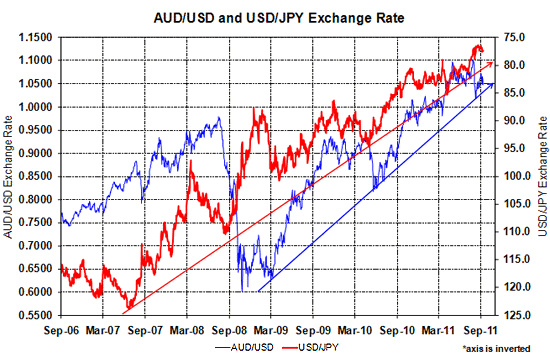
 By Roger J Kerr
By Roger J Kerr
There were always a number of pre-conditions for the NZD/USD exchange rate direction to reverse and head downwards.
A number of those pre-conditions have been fulfilled in terms of the variables that drive the NZD/USD movements:
- The EUR/USD exchange rate has finally succumbed to the debt and economic problems in Europe with the resignation of German representative Juergen Stark from the ECB Board causing widespread Euro selling that pushed the EUR/USD rate well below $1.40 to $1.36. European unity is now definitely under the hammer.
- New Zealand interest rates are clearly not increasing as soon as previously expected and by not as far. Slower global growth and the high NZD value adds to lower NZ GDP growth, thus lower inflation risks and as a consequence no rush for the RBNZ to put interest rates up.
- Decreasing PMI and ISM manufacturing indices across the world add to lower industrial demand for commodities, thus reducing commodities prices. A revision downwards in global growth forecasts has also been negative for commodity prices over recent weeks.
- The dairy industry drives the export engine room of the NZ economy and international dairy prices have been correcting down for three months now. Wholemilk powder prices have fallen at each of the last six Fonterra/Global Dairy Trade on-line auctions, the price plummeting from highs of USD5,000/MT to USDD3,200/MT. Fonterra have maintained their $7 milksolids payout forecast to date, however it must be under pressure for revision down at some point.
- Global investors and currency speculators have substantially reduced their interest in growth/commodity currencies like the Kiwi dollar, as risk appetite plummets in sharemarkets following the US debt crisis in August and the ongoing European problems. The NZD/USD rate still has some catching up to do on the sharply lower Dow Jones sharemarket index.
However, the over-riding determinant of the NZD/USD value is the Australian dollar movements against the USD.
While the AUD/USD rate has retreated to below $1.0500, it still remains elevated compared to other currencies due to the higher Australian interest rates and the mining/resources boom.
The above-listed drivers of the NZ dollar all suggest a rate in the mid to low 0.7000’s, however it is the Australian dollar strength that holds the rate above 0.8000.
Therefore any analysis and prognosis on near term NZ dollar direction has to concentrate on what could change in Australia to force a loss of confidence in their economy and currency.
The four big issues ahead of Australia that will determine the AUD direction over coming months are seen as follows:
- Weaker domestic economic figures coupled with lower global growth forcing the RBA to lean towards cutting interest rates, in line with current moneymarket pricing.
- Weaker Chinese economic numbers as internal infrastructure spend slows due to tighter monetary conditions in China and export factories not demanding the workers (thus infrastructure build) as rapidly as previously.
- Metal and mining commodity prices falling further as Chinese demand wanes. Hard-coking coal prices internally in China have dropped to USD180 per tonne, which must pull down the USD280 per tonne international price Australia receives.
- Politically it is all turning to custard for the Gillard Labour government, with higher mortgage interest rates and less jobs (mainly due to the overvalued Aussie dollar) causing the masses to revolt.
It is hard to see any positives or upside for the Australian dollar from here given the aforementioned outlook.
While the negatives may encourage international investors out of the Australian dollar the problem they face is where to put their money as an alternative. The Swiss authorities have made decisions to stop global funds coming into their currency. The end conclusions is that the US dollar itself has to strengthen against currencies like the Euro, Japanese Yen, AUD and NZD.
An improvement in US employment figures over coming months, coupled with a creditable fiscal plan from the Joint Panel in November will assist the positive sentiment towards the USD.
Further AUD selling has to be expected in this environment, a break below $1.0300 in the AUD/USD rate (currently $1.0440) would see the uptrend in the AUD since March 2009 broken (see chart below).
A further move lower in the AUD/USD rate below $1.000 would see the support at 0.7800 in the NZD/USD rate being tested.
A more dovish tone than anticipated in this Thursday’s monetary policy statement from the RBNZ may be the catalyst the spark the initial NZD selling.
Standard and Poor’s would have every justification to be re-examining New Zealand’s sovereign credit rating as weaker GDP growth in 2012 than what is currently in Treasury’s forecasts points to a weaker than forecast fiscal position. The credit rating downgrade risk for the Kiwi dollar could well re-emerge over coming weeks.

No chart with that title exists.
--------------------
* Roger J Kerr runs Asia Pacific Risk Management. He specialises in fixed interest securities and is a commentator on economics and markets. More commentary and useful information on fixed interest investing can be found at rogeradvice.com

We welcome your comments below. If you are not already registered, please register to comment
Remember we welcome robust, respectful and insightful debate. We don't welcome abusive or defamatory comments and will de-register those repeatedly making such comments. Our current comment policy is here.